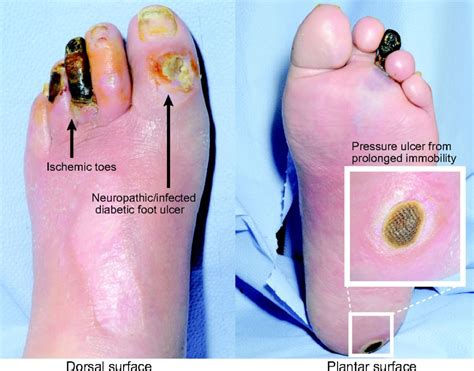Diabetic Foot Ulcers: Causes, Symptoms, Treatment
Diabetic Foot Ulcers FAQ
What is diabetic foot ulceration?
Diabetic foot ulceration is a devastating complication of diabetes that is associated with infection, amputation, and death, and is affecting increasing numbers of patients with diabetes mellitus. The pathogenesis of foot ulcers is complex, and different factors play major roles in different stages.
Are diabetic foot ulcers a complication?
Diabetic foot ulcers are responsible for more admissions than any other diabetic complication. Today, diabetes is the leading cause of non-traumatic amputations in the US. Overall, about 5% of patients with diabetes mellitus develop foot ulcers and 1% end up with an amputation.
What causes diabetic foot ulcers?
StatPearls [Internet]. Tony I. Oliver; Mesut Mutluoglu. Last Update: August 8, 2023. Diabetic foot ulcers are among the most common complications of patients who have diabetes mellitus which is not well controlled. It is usually the result of poor glycemic control, underlying neuropathy, peripheral vascular disease, or poor foot care.
How common is diabetic foot ulcer?
The annual incidence of diabetic foot ulcer worldwide is between 9.1 to 26.1 million. Around 15 to 25% of patients with diabetes mellitus will develop a diabetic foot ulcer during their lifetime. As the number of newly diagnosed diabetics are increasing yearly, the incidence of diabetic foot ulcer is also bound to increase.
Can diabetics get foot ulcers?
Some people with diabetes develop foot ulcers, due to poor skin circulation and reduced sensation in the feet. Regular examination of the feet and good diabetic control helps to prevent them. A foot ulcer is prone to infection, which may become severe. Ulcers sometimes need treatment with dressings, medication and, when appropriate, surgery.
Can diabetes foot ulcers be prevented?
There are lots of things you can do to help prevent diabetes foot ulcers: Diabetic foot wounds have a particularly high recurrence rate of around 40% at one year and up to 75% by year five. It is therefore more helpful to think of a diabetes foot ulcer as being in ‘remission’ rather than ‘healed’
Can a diabetic foot ulcer bleed?
Diabetic foot ulcers are sometimes hidden beneath hard skin and can gather dead tissue around them. The podiatrist will need to remove this to help your ulcer heal. This can cause the ulcer to bleed a little but this is completely normal. Do not try to treat the ulcer yourself.
How are diabetic foot ulcers treated?
Treatment for diabetic foot ulcers involves 1 or more of the following: offloading, in which a plaster cast is used to take pressure off the ulcer and help with healing clearing away the dead, damaged and infected skin from the ulcer (the medical name for this is debridement) using dressings while the ulcer heals.
Diabetic Foot Ulcers References
If you want to know more about Diabetic Foot Ulcers, consider exploring links below:
What Is Diabetic Foot Ulcers
- https://www.nice.org.uk/guidance/ng19/ifp/chapter/diabetic-foot-ulcer
- https://www.ncbi.nlm.nih.gov/books/NBK537328/
- https://www.england.nhs.uk/north-east-yorkshire/wp-content/uploads/sites/49/2019/07/foot-ulcer-information-guide.pdf
- https://www.healthline.com/health/diabetic-foot-pain-and-ulcers-causes-treatments
- https://www.bmj.com/content/359/bmj.j5064
- https://www.verywellhealth.com/diabetic-ulcer-7969012
- https://emedicine.medscape.com/article/460282-overview
Diabetic Foot Ulcers Information
- https://patient.info/diabetes/diabetes-mellitus-leaflet/diabetes-foot-care
- https://www.wsh.nhs.uk/CMS-Documents/Patient-leaflets/DiabetesUnit/6102-1-Diabetes-Foot-Care-for-a-Foot-Ulcer-new.pdf
- https://cddft.nhs.uk/media/792817/foot%20ulcer%20information%20cddft.pdf
- https://legsmatter.org/information-and-support/types-of-ulcers/diabetes-foot-ulcers/
Explore Related Topics
Nanotherapeutics for Diabetic Wound Healing: A Promising Solution?
How can nanotherapeutics accelerate the healing of diabetic wounds?
